Documents: Go to download!
User Manual
- Owner's manual - (English)
- Quick Reference Guide - (English)
- Notification about included accessories - (English)
- Accessories catalog - (English)
- KNOWING YOUR SEWING MACHINE
- USEFUL SEWING TIPS
- MAINTENANCE
- TROUBLESHOOTING
- ERROR MESSAGES
Table of contents
User Manual Sewing Machine
KNOWING YOUR SEWING MACHINE
ACCESSORIES
Included accessories
After opening the box, check that the following accessories are included. If any item is missing or damaged, contact your dealer.

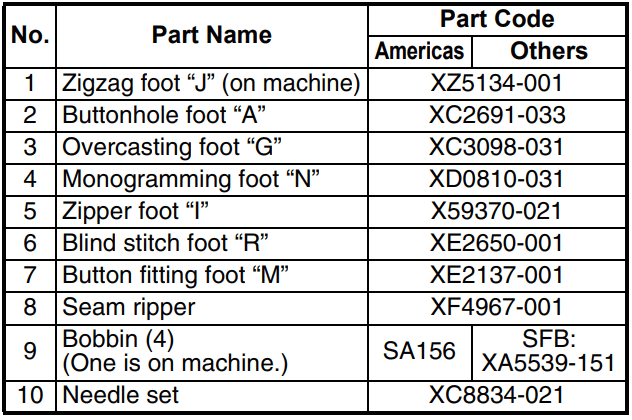
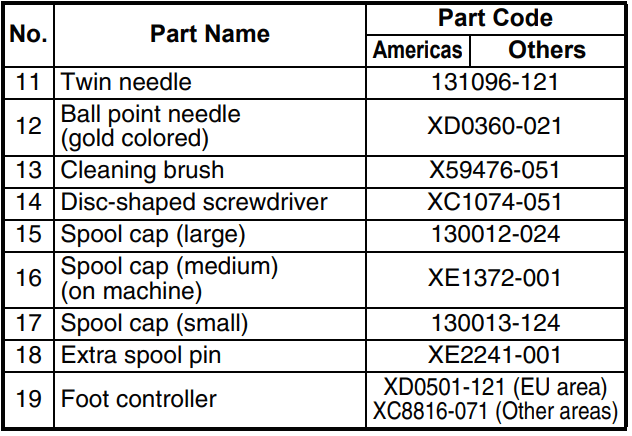
Optional accessories
The following are available as optional accessories to be purchased separately. Depending on the model you purchased, the following accessory may be included with your machine.

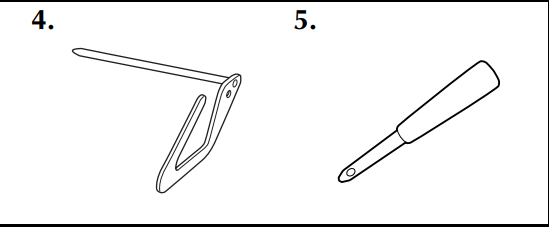


Accessory compartment
The accessories are stored in a compartment inside the flat bed attachment.
For models equipped with an open type flat bed attachment
Open the compartment as shown in the figure below.

1. Flat bed attachment
2. Storage compartment
For models equipped with a slide type flat bed attachment
Slide the flatbed attachment to the left to open it.
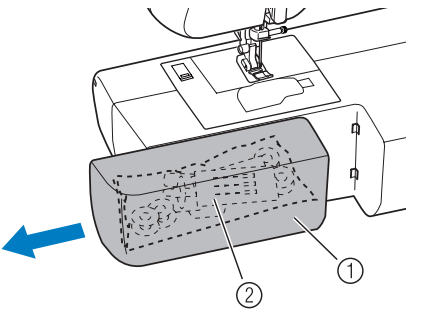
1. Flat bed attachment
2. Storage compartment
NAMES OF MACHINE PARTS AND THEIR FUNCTIONS
The main parts
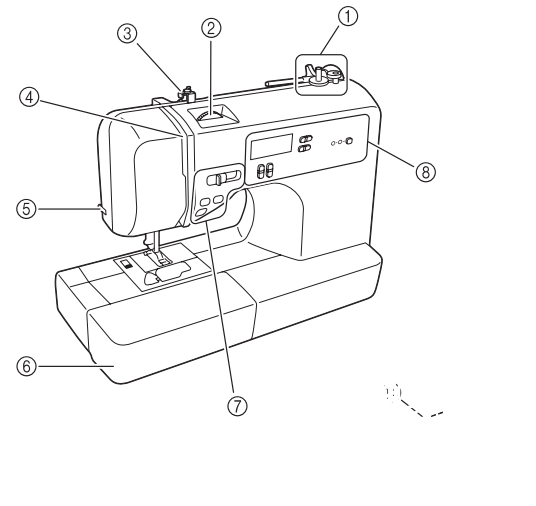

1. Bobbin winder (page 17) : This winds the thread onto the bobbin for use as the lower thread.
2. Upper tension-control dial (page 43) : This controls the tension of the upper thread.
3. Bobbin-winding thread guide and pre-tension disc (page 19) : Pass the thread under this thread guide and around the pre-tension disc when winding the bobbin thread.
4. Thread take-up lever (page 27)
5. Thread cutter (page 42) : Pass the threads through the thread cutter to cut them.
6. Flat bed attachment with accessory compartment (page 7 and 46)
7. Operation buttons (page 9) : The operation buttons differ depending on the sewing machine model.
8. Operation panel (page 10) : This is used to select the stitch and specify the various settings. Design and position of the operation panel differs depending on the sewing machine model.
9. Spool pin (page 11, 17 and 25) : This holds the spool of thread.
10. Handwheel : This is used to manually raise and lower the needle.
11. Air vent : This vent allows the air surrounding the motor to circulate. Do not cover the air vent while the sewing machine is being used.
12. Main power and sewing light switch (page 14) : You can turn the main power and sewing light switch on and off.
13. Jack/socket connector (page 14) : Insert the plug on the power supply cord into the jack/ socket connector.
14. Foot controller (page 14) : You can use this to control the sewing speed, and to start and stop sewing.
15. Foot controller jack/socket (page 14) : Plug in the foot controller plug.
16. Feed dog position lever (page 57 and 67) : Use the feed dog position lever to lower the feed dogs.
17. Presser foot lever (page 25) : This is used to raise and lower the presser foot. r
18. Thread guide (page 18 and 27) : This is used when winding the thread onto the bobbin and then threading the machine.
19. Thread guide cover (page 18 and 27) : Pass the thread under this thread guide when winding the bobbin thread and threading the machine.
20. Handle : Carry the sewing machine by its handle when transporting the machine.
Needle and presser foot section
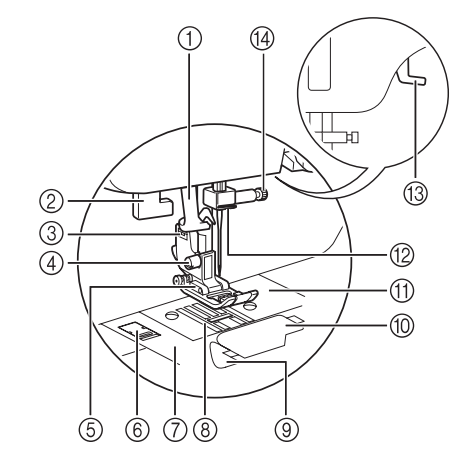
1. Needle threader (for models equipped with the needle threader) (page 28)
2. Buttonhole lever : Lower the buttonhole lever when sewing buttonholes and bar tacks.
3. Presser foot holder : The presser foot is installed onto the presser foot holder.
4. Presser foot holder screw : Use the presser foot holder screw to hold the presser foot holder in place.
5. Presser foot : The presser foot applies pressure consistently on the fabric as the sewing takes place. Attach the appropriate presser foot for the selected stitching.
6. Needle plate cover release : Use when removing the needle plate cover.
7. Needle plate cover : Remove the needle plate cover to clean the race.
8. Feed dogs : The feed dogs feed the fabric in the sewing direction.
9. Quick-set bobbin (for models equipped with the quickset bobbin) : You can start sewing without pulling up the bobbin thread.
10. Bobbin cover : Open the bobbin cover to set the bobbin.
11. Needle plate : The needle plate is marked with guides for sewing straight seams.
12. Needle bar thread guide : Pass the upper thread through the needle bar thread guide.
13. Presser foot lever : Raise and lower the presser foot lever to raise and lower the presser foot.
14. Needle clamp screw : Use the needle clamp screw to hold the needle in place
Operation buttons
The operation buttons help you to easily perform various basic sewing machine operations. The operation buttons differ depending on the sewing machine model.


1. Reverse/reinforcement stitch button 
Press the reverse/reinforcement stitch button to sew reverse stitches. Reverse stitches are sewn by keeping the button pressed down to sew in the opposite direction. For details, refer to “Sewing reinforcement stitches” (page 42).
2. Start/stop button 
Press the start/stop button to start or stop sewing. The machine sews at a slow speed at the beginning of sewing while the button is pressed. When sewing is stopped, the needle is lowered in the fabric. For details, refer to “Starting to sew” (page 41).
3. Needle position button 
Press the needle position button to raise or lower the needle. Be sure to raise the needle before threading the needle. Use this button to change the sewing direction or for detailed sewing in small areas. Pressing the button twice sews one stitch.
4. Sewing speed controller
Slide the sewing speed controller to adjust the sewing speed.
Operation panel
The operation panel, located on the front of the sewing machine, allows you to select a stitch and specify how the stitch will be sewn. The operation panel differs depending on the sewing machine model.
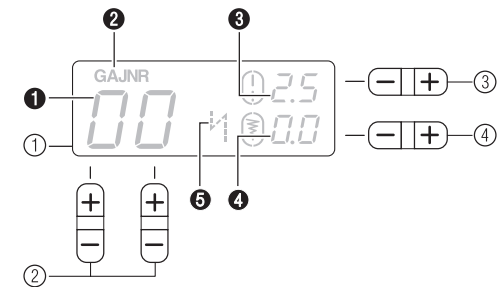
1. LCD (liquid crystal display) : The number of the selected stitch (1), the presser foot type to be used (2), the stitch length (mm) (3), the stitch width (mm) (4), and the auto reverse/ reinforcement (5) are displayed here.
2. Stitch selection keys : Press the stitch selection keys, and then select the number for the stitch that you wish to use. For details, refer to “Selecting a stitch” (page 39).
3. Stitch length adjustment key : Press this key to adjust the stitch length. (Press the “–” side to reduce the stitch length; press the “+” side to increase the stitch length.)
4. Stitch width adjustment key : Press this key to adjust the stitch width. (Press the “–” side to reduce the stitch width; press the “+” side to increase the stitch width.)
■ Keys and indicators provided on some models
<For models equipped with satin stitches and 1 font type of character stitches>

5. Stitch category selection key : Press this key to select desired stitch category. For details, refer to “Selecting a stitch” (page 39) .
6. Utility stitch indicator : This indicator lights up when the utility stitch is selected with the stitch category selection key.
7. Satin stitch indicator : This indicator lights up when the satin stitch is selected with the stitch category selection key.
8. Character stitch indicator (for models equipped with character stitches) : This indicator lights up when the character stitch is selected with the stitch category selection key.
<For models equipped with satin stitches and 2 font type of character stitches>
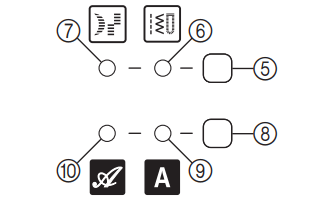
5. Utility stitch key : Press this key to select the desired type of utility stitches. For details, refer to “Selecting a stitch” (page 39).
6. Utility stitch indicator : This indicator lights up when the utility stitch is selected with the utility stitch key.
7. Satin stitch indicator : This indicator lights up when the satin stitch is selected with the utility stitch key.
8. Character stitch key : Press this key to select the desired font type of character stitches. For details, refer to “Selecting characters” (page 76).
9. Character stitch indicator (Gothic font) : This indicator lights up when the character stitch (Gothic font) is selected with the character stitch key.
10. Character stitch indicator (Script font) : This indicator lights up when the character stitch (Script font) is selected with the character stitch key.
Spool pin
As shown, press down on the spool pin lever with your finger to raise the spool pin.

■ Storing the spool cap
The enclosed spool cap (large, medium, small) can be stored by attaching it to the spool pin as shown in the illustration. When attaching the spool cap, position it with the rounded side toward the spool pin.

■ Storing the spool pin
When placing the cover on the sewing machine before storing or if the spool pin will not be used, return the spool pin to its storage position. Remove the spool from the spool pin, and then fold up the spool pin, as shown in the illustration, until it snaps into place to secure it.
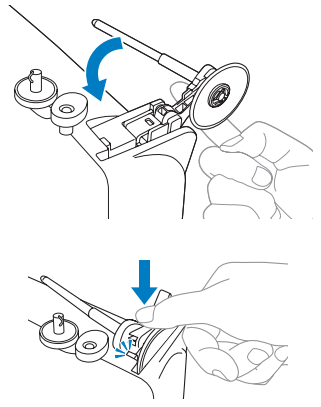
■ Installing the spool pin
1. If the spool pin has been removed from the machine, insert the tab on the spool pin into the hole on the back of the machine, as shown.
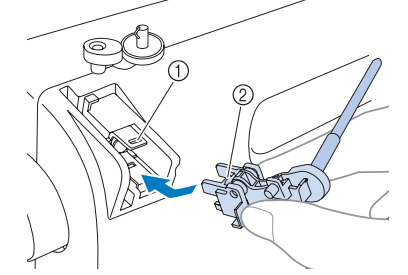
- Hole
- Tab
2. Push the spool pin down until it locks into place.
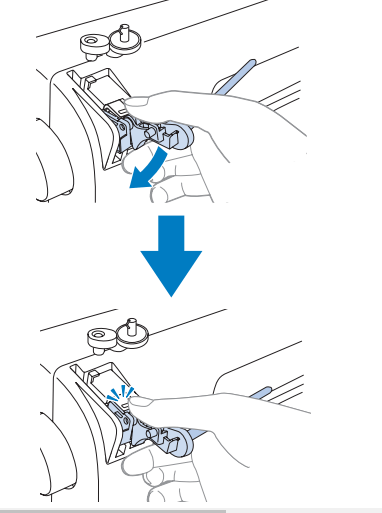
Flip chart
You can check the pattern numbers of the stitches using the flip chart on the machine. Hold the notch with your finger to flip the chart.
For models equipped with a flip chart on the top panel

For models equipped with a flip chart on the front panel
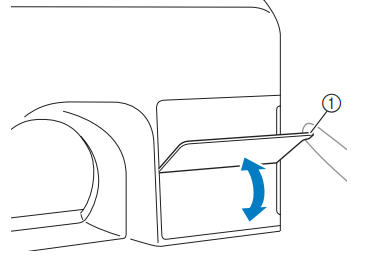
1. Notch
USING YOUR SEWING MACHINE
Power supply precautions
Be sure to observe the following precautions concerning the power supply
Power supply
1. Insert the plug into a wall outlet.

1. Main power switch
2. Jack/socket connector
2. Set the main power switch to “I”.
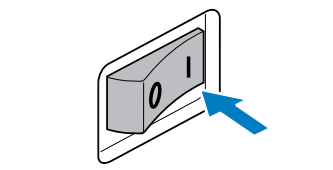
The sewing light comes on when the machine is turned on.
3. To turn off the machine, set the main power switch to “ ”.
”.
The sewing light goes off when the machine is turned off.
Foot controller
Insert the foot controller plug into its jack/socket on the rear side of the sewing machine.
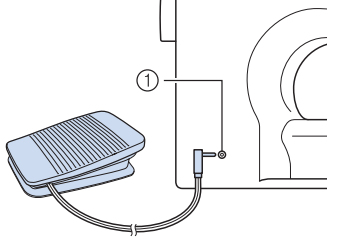
1. Foot controller jack/socket
When you press the foot controller down lightly, the machine will run at a low speed. When you press harder, the machine’s speed will increase. When you take your foot off the foot controller, the machine will stop.
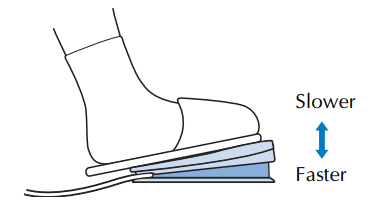
You should make sure that nothing is placed on the foot controller when the machine is not in use.
Sewing speed controller (for models equipped with the start/stop button)
1.Slide the sewing speed controller to the left or right to select the desired sewing speed.
Slide the sewing speed controller to the left to sew at a slower speed, or slide the speed controller to the right to sew at a faster speed.

1. Sewing speed controller
• The speed set using the sewing speed controller is the foot controller’s maximum sewing speed.
Changing the needle stop position
Normally, the sewing machine is set to leave the needle in the fabric when sewing is stopped. Instead, the machine can be set to leave the needle raised when sewing is stopped.
1.Turn off the sewing machine.
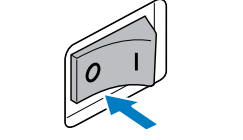
2.Hold down the “–” side of  (stitch selection key) on the left and turn on the sewing machine
(stitch selection key) on the left and turn on the sewing machine
After turning on the sewing machine, release the “–” side of  (stitch selection key).
(stitch selection key).
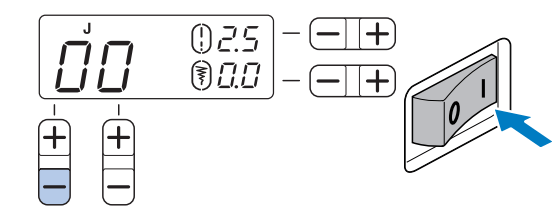
Changing the initial needle position
Normally, the straight stitch (left needle position) is automatically selected when the sewing machine is turned on. The machine can be set so that the straight stitch (center needle position) is automatically selected when it is turned on.
1.Turn off the sewing machine.

2.Hold down the “+” side of  (stitch selection key) on the left and turn on the sewing machine.
(stitch selection key) on the left and turn on the sewing machine.
After turning on the sewing machine, release the “+” side of  (stitch selection key).
(stitch selection key).

Cancelling the operation beep
When the sewing machine is purchased, it is set to beep each time a key is pressed. This setting can be changed so that the machine does not beep.
1.Turn off the sewing machine.

2.Hold down the “–” side of  (stitch width adjustment key) and turn on the sewing machine.
(stitch width adjustment key) and turn on the sewing machine.
After turning on the sewing machine, release the “-” side of  (stitch width adjustment key).
(stitch width adjustment key).
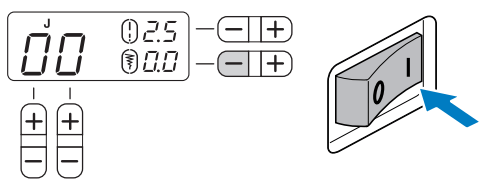
THREADING THE MACHINE
Winding the bobbin
This section describes how to wind the thread onto the bobbin. • For details on the fast bobbin winding, see page 20.
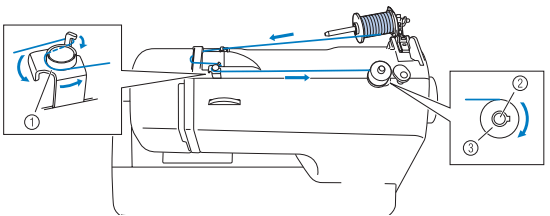
1. Bobbin-winding thread guide
2. Bobbin winder shaft
3. Bobbin
1.As shown, press down on the spool pin lever with your finger.
The spool pin swings up
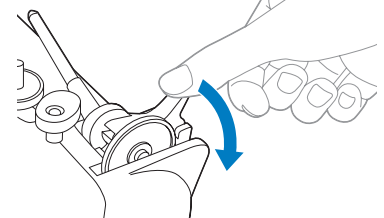
2.Remove the spool cap.

1. Spool pin
2. Spool cap
3.Fully insert the spool of thread for the bobbin onto the spool pin
Slide the spool onto the pin so that the spool is horizontal and the thread unwinds to the front at the bottom.
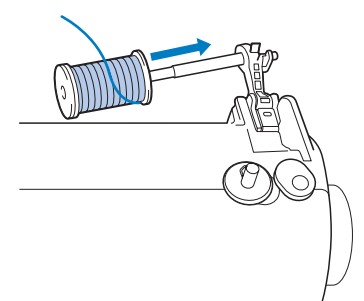
4.Slide the spool cap onto the spool pin.
With the slightly rounded side of the spool cap positioned toward the left, slide the spool cap onto the spool pin as far as possible to the right so that the spool is moved to the right end of the spool pin.
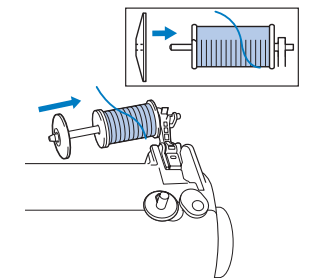
5.While holding the spool with your right hand, and then pass the thread under the thread guide.

1. Thread guide
6.Pass the thread under the thread guide cover from the back to the front.
Hold the thread with your right hand so that there is no slack in the thread that is pulled out, and then pass the thread under the thread guide cover with your left hand.
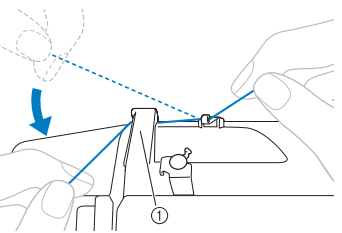
1. Thread guide cover
7.Pull the thread to the right, pass it under the hook of the bobbin-winding thread guide, and then wind the thread counterclockwise between the discs, pulling it in as far as possible.
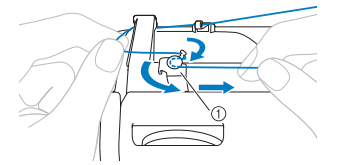
1. Bobbin-winding thread guide
Make sure that the thread passes under the pre-tension disk.
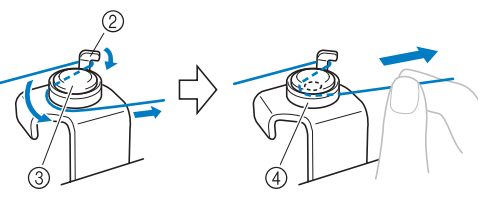
2. Hook
3. Pre-tension disk
4. Pull it in as far as possible.
8.Put the bobbin onto the bobbin winder shaft and slide the bobbin winder shaft to the right. Turn the bobbin clockwise, by hand, until the spring on the shaft slides into the notch in the bobbin.
• Make sure to pull out 7 to 10 cm (2-3/4 to 3-15/16 inches) of thread from the hole on the bobbin.
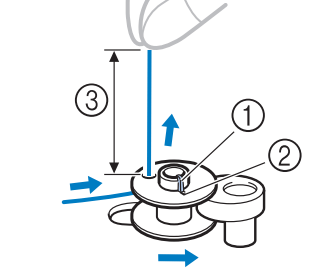
1. Spring on the shaft
2. Notch
3. 7 – 10 cm (2-3/4 – 3-15/16 inches)
9.Turn on the sewing machine.
10.While holding the end of the thread, gently press the foot controller or press (start/stop button) (for models equipped with the start/ stop button) to wind the thread around the bobbin a few times. Then stop the machine.
(start/stop button) (for models equipped with the start/ stop button) to wind the thread around the bobbin a few times. Then stop the machine.
11.Trim the excess thread above the bobbin.
• Pull 1 cm (3/8 inch) of thread from the hole on the bobbin.
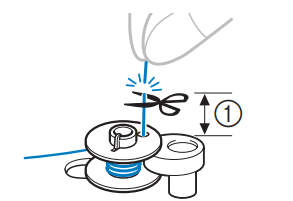
1. 1 cm (3/8 inch)
12.Slide the sewing speed controller to the right (to set the speed to fast). (For models equipped with the sewing speed controller.)

1.Sewing speed controller
13.Press the foot controller or press (start/ stop button) (for models equipped with the start/stop button) to start.
(start/ stop button) (for models equipped with the start/stop button) to start.

14.When the bobbin seems full and begins spinning slowly, take your foot off the foot controller or press (start/stop button) (for models equipped with the start/stop button).
(start/stop button) (for models equipped with the start/stop button).
15.Cut the thread, slide the bobbin winder shaft to the left and remove the bobbin
16.Slide the sewing speed controller back to its original position (for models equipped with the sewing speed controller).
■ For models equipped with the fast bobbin winding system
1.Place the bobbin on the bobbin winder shaft so that the spring on the shaft fits into the notch in the bobbin.

1. Notch
2. Bobbin winder shaft spring
2.Slide the bobbin winder shaft to the right.
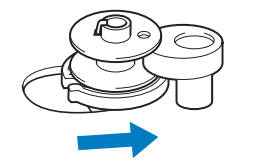
3.Follow steps 1 through 7 of the procedure in “Winding the bobbin” to pass the thread around the pre-tension disk (page 17).
4.While holding the thread that wraps around the pre-tension disk with your left hand, use your right hand to wind the free end of the thread clockwise around the bobbin five or six times.

5.Pull the thread to the right and pass it through the slit in the bobbin winder seat.

1. Slit in bobbin winder seat (with built-in cutter)
6.Slide the sewing speed controller to the right (to set the speed to fast) (for models equipped with the sewing speed controller).
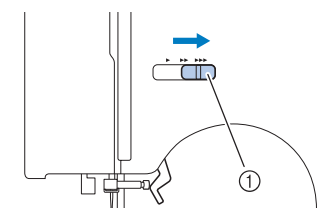
1. Sewing speed controller
7.Turn on the sewing machine.
8.Press the foot controller or press (start/ stop button) (for models equipped with the start/stop button) to start.
(start/ stop button) (for models equipped with the start/stop button) to start.
9.When the bobbin begins spinning slowly, take your foot off the foot controller or press  (start/stop button) (for models equipped with the start/stop button).
(start/stop button) (for models equipped with the start/stop button).
10.Cut the thread, slide the bobbin winder shaft to the left, and then remove the bobbin from the shaft.
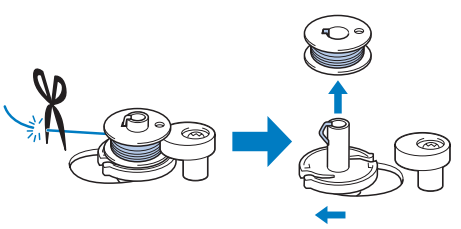
11.Slide the sewing speed controller back to its original position (for models equipped with the sewing speed controller).
Lower threading
Install the bobbin wound with thread.
• For more details on quick-set bobbin, see page 23
1.Raise the needle to its highest position by turning the handwheel toward you (counterclockwise) or press (needle position button) (for models equipped with the needle position button), and raise the presser foot lever.
(needle position button) (for models equipped with the needle position button), and raise the presser foot lever.
2.Turn off the sewing machine.
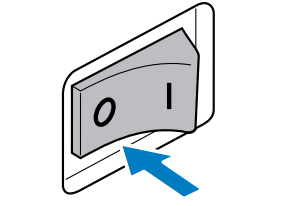
3.Slide the button and open the cover.
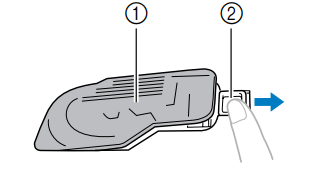
1. Cover
2. Slide button
4.Put the bobbin in so the thread comes out in the direction shown by the arrow.

5.Hold the end of the thread, push the bobbin down with your finger, and then pass the thread through the slit, as shown.
• If the thread is not correctly inserted through the tension-adjusting spring of the bobbin case, it may cause incorrect thread tension (page 43).

1. Tension-adjusting spring
■ For models equipped with the quick-set bobbin
1.Raise the needle to its highest position by turning the handwheel toward you (counterclockwise) or press  (needle position button) (for models equipped with the needle position button), and raise the presser foot lever.
(needle position button) (for models equipped with the needle position button), and raise the presser foot lever.
2.Turn off the sewing machine.
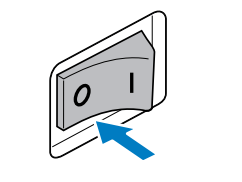
3.Slide the button and open the cover.

1.Cover
2.Slide button
4.Insert the bobbin with your right hand so that the end of the thread is on the left, and then, after pulling the thread firmly around the tab with your left hand as shown, lightly pull the thread to guide it through the slit.
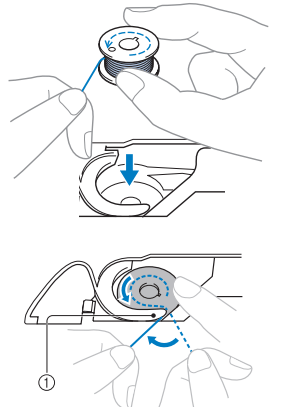
1. Tab
5.While lightly holding down the bobbin with your right hand as shown, guide the thread through the slit (1 and 2).
• At this time, check that the bobbin easily rotates counterclockwise. Then, pull the thread toward you to cut it with the cutter (3).
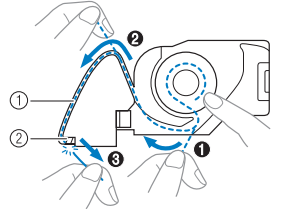
1.Slit
2.Cutter (Cut the thread with the cutter.)
6.Replace the bobbin cover. Put the left tab in place (see arrow 1), and then press lightly on the right side (see arrow 2) until the cover clicks into place.

Upper threading
Set the upper thread and thread the needle.
• For details on the needle threader, see page 28.
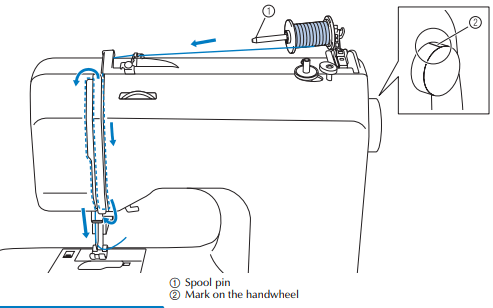
1. Turn on the sewing machine.
2. Raise the presser foot using the presser foot lever.
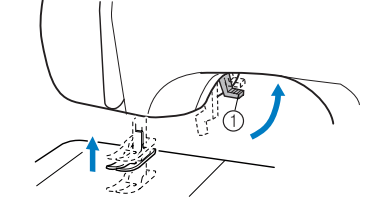
1.Presser foot lever
3.Raise the needle by turning the handwheel toward you (counterclockwise) so that the mark on the wheel points up, or press  (needle position button) (for models equipped with the needle position button) once or twice to raise the needle.
(needle position button) (for models equipped with the needle position button) once or twice to raise the needle.

- Mark
- Needle position button
- If the needle is not correctly raised, the sewing machine can not be threaded. Be sure to turn the handwheel so that the mark on the wheel points up before threading the sewing machine.
4.As shown, press down on the spool pin lever with your finger.

5.Remove the spool cap

1. Spool pin
2. Spool cap
6.Fully insert the spool for the upper thread onto the spool pin.
Slide the spool onto the pin so that the spool is horizontal and the thread unwinds to the front at the bottom.

7.Slide the spool cap onto the spool pin
With the slightly rounded side of the spool cap positioned toward the left, slide the spool cap onto the spool pin as far as possible to the right so that the spool is moved to the right end of the spool pin.
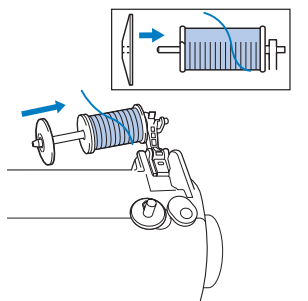
8.While holding the spool with your right hand, and then pass the thread under the thread guide.

1. Thread guide
9.Pass the thread under the thread guide cover from the back to the front. Hold the thread with your right hand so that there is no slack in the thread that is pulled out, and then pass the thread under the thread guide cover with your left hand.
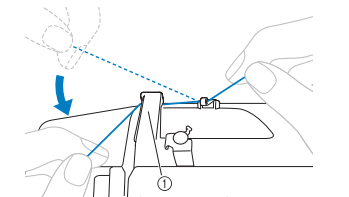
1.Thread guide cover
10.Feed the upper thread as shown in the illustration below.

11.Make sure you guide the thread through the thread take-up lever from right to left as shown in the illustration below.
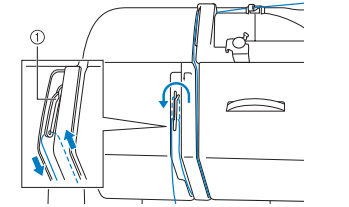
1. Thread take-up lever
12.Put the thread behind the needle bar thread guide above the needle.
The thread can easily be passed behind the needle bar thread guide by holding the thread in your left hand, then feeding the thread with your right hand.
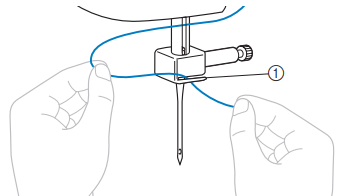
1. Needle bar thread guide
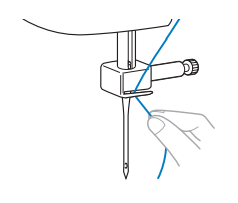
13.Turn off the sewing machine.
14.Thread the needle from front to back and pull out about 5 cm (2 inches) of thread.
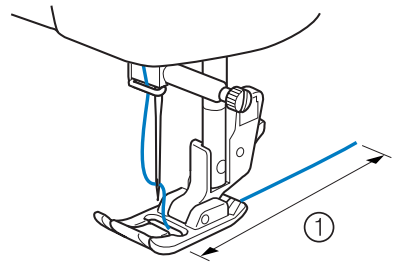
1. 5 cm (2 inches)
■ Using the needle threader (for models equipped with the needle threader)
1.Follow steps 1 through 13 of the procedure in “Upper threading” to thread the machine to the needle bar thread guide.
2.Lower the presser foot lever.
3.While lowering the needle threader lever, hook the thread onto the guide.

1. Needle holder
2. Needle threader lever
3. Guide
4.Fully lower the needle threader lever.

5.Catch the thread on the hook as shown below.
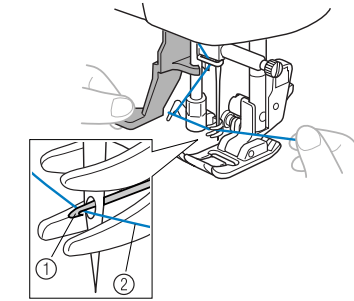
1. Hook
2. Thread
6.While lightly holding the thread, release the needle threader lever. The hook will pull the thread through the needle.

7.Pull the loop of the thread passed through the eye of the needle toward the rear of the machine.
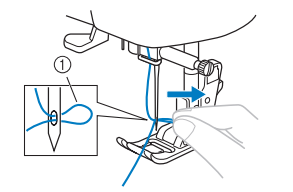
8.Raise the presser foot lever.

9.Pass the end of the thread through the presser foot, and then pull out about 5 cm (2 inches) of thread toward the rear of the machine
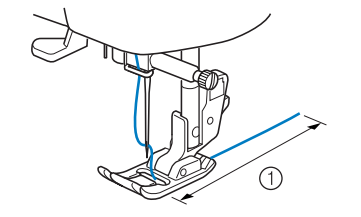
1. 5 cm (2 inches)
Drawing up the lower thread
1.Lightly hold the end of the upper thread.
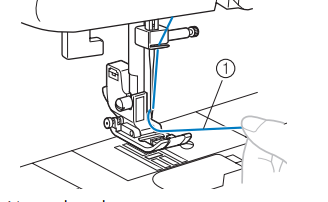
1. Upper thread
2.While holding the end of the upper thread, raise the needle either by turning the handwheel toward you (counterclockwise) so that the mark on the wheel points up or by pressing  (needle position button) (for models equipped with the needle position button) once or twice.
(needle position button) (for models equipped with the needle position button) once or twice.
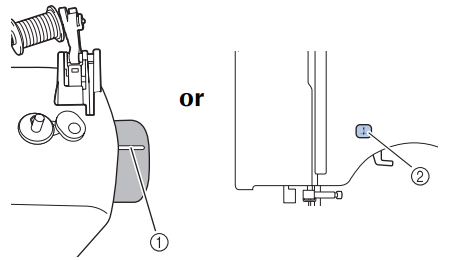
1. Mark
2. Needle position button
3.Pull on the upper thread to draw up the lower thread.

1. Upper thread
2. Lower thread
4.Pull out about 10 cm (4 inches) of both threads and pull them toward the back of the machine under the presser foot.
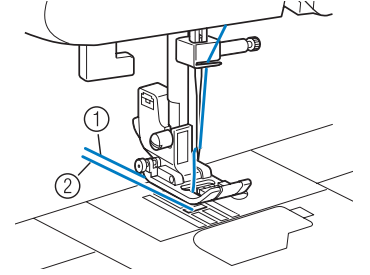
1.Upper thread
2. Lower thread
■ For models equipped with the quick-set bobbin
You can begin sewing immediately without drawing up the bobbin thread. When sewing gathers or darts, you can draw up the lower thread by hand so that some thread will be left over. Before you draw up the lower thread, put the bobbin back in.
1.Pass the thread along the slit in the direction of the arrow, and leave it there without cutting it.
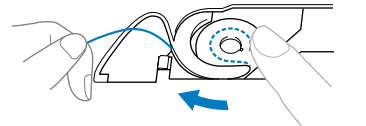
• The bobbin cover should still be removed.
2.Draw up the lower thread as described in steps 1 to 4.
3.Replace the bobbin cover.
REPLACING THE NEEDLE
Needle precautions
Be sure to observe the following precautions concerning the handling of the needle. Failure to observe these precautions is extremely dangerous. Be sure to read and carefully follow the instructions below.
Needle types and their uses
The sewing machine needle that should be used depends on the fabric and thread thickness. Refer to the following table when choosing the thread and needle appropriate for the fabric that you wish to sew.

■ Ball point needle : Use the ball point needle when sewing on stretch fabrics or fabrics where skipped stitches easily occur. Use the ball point needle for best results when sewing patterns using monogramming foot “N”. The factory recommended needle is “HG-4BR” (Organ). Schmetz needles “JERSEY BALL POINT” 130/705H SUK 90/14 may be used as a substitute
■ Transparent nylon thread Use a 90/14 to 100/16 needle, regardless of the fabric or thread.
Checking the needle
Sewing with a bent needle is extremely dangerous since the needle may break while the machine is being operated. Before using the needle, place the flat side of the needle on a flat surface and check that the distance between the needle and the flat surface is even.
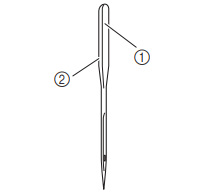
1. Flat side
2. Needle type marking
■ Correct needle
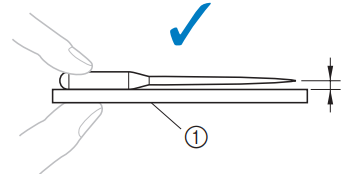
1. Flat surface
■ Incorrect needle
If the distance between the needle and the flat surface is not even, the needle is bent. Do not use a bent needle.
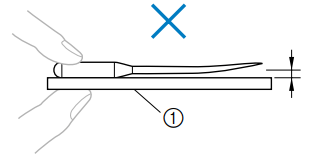
1.Flat surface
Replacing the needle
Replace the needle as described below. Use the disc-shaped screwdriver and a needle that has been determined to be straight according to the instructions in “Checking the needle”.
1.Raise the needle by turning the handwheel toward you (counterclockwise) so that the mark on the wheel points up. (With models equipped with (needle position button), raise the needle by pressing
(needle position button), raise the needle by pressing  once or twice.)
once or twice.)
2.Turn off the sewing machine.

3.Lower the presser foot lever.
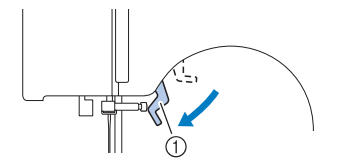
1. Presser foot lever
4.Hold the needle with your left hand, and then use a disc-shaped screwdriver to turn the needle clamp screw counterclockwise to remove the needle.
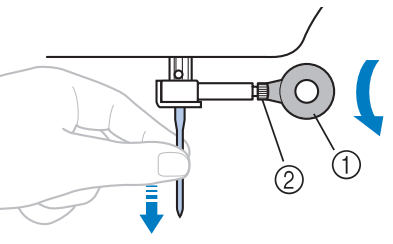
1. Disc-shaped screwdriver
2. Needle clamp screw
• Do not apply strong force when loosening or tightening the needle clamp screw, otherwise certain parts of the sewing machine may be damaged.

5.With the flat side of the needle toward the rear of the machine, insert the needle until it touches the needle stopper.
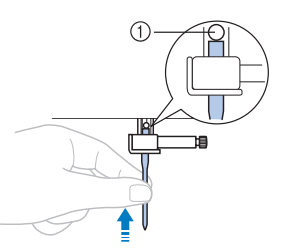
1. Needle stopper
6.While holding the needle with your left hand, use the disc-shaped screwdriver to tighten the needle clamp screw by turning it clockwise.
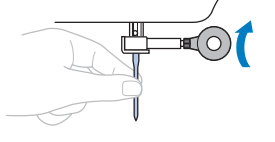
Install the twin needle in the same way.
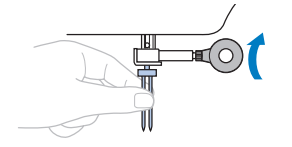
Sewing with the twin needle
We have designed your machine so you can sew with this needle and two top threads. You can use the same color or two different colors of thread for making decorative stitches. For details on the stitches that can be sewn with the twin needle, refer to “STITCH SETTINGS” (page 82).
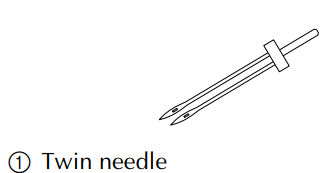
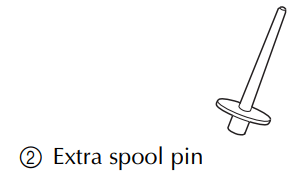
1.Install the twin needle.
• For details on installing a needle, refer to “Replacing the needle” (page 32).
2.Thread the upper thread for the left needle.
• For details, refer to steps 1 through 12 of “Upper threading” (page 25).
3.Manually thread the left needle with the upper thread.
Pass the thread through the eye of the needle from the front to the back.
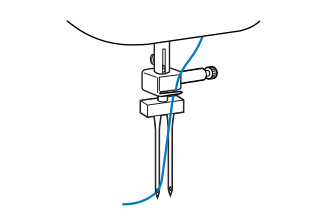
4.Insert the extra spool pin onto the end of the bobbin winder shaft.
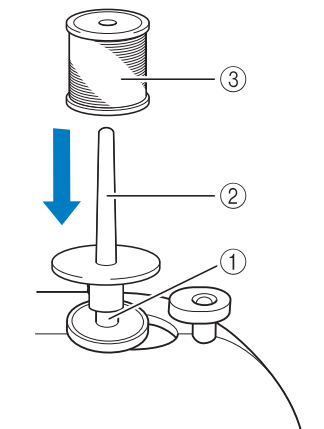
1. Bobbin winder shaft
2. Extra spool pin
3. Thread spool
5.Install the thread spool and thread the upper thread.
6.Thread the upper thread for the right side in the same way that the upper thread for the left side was threaded.

1. Thread guide cover
7.Without passing the thread through the needle bar thread guide, manually thread the right needle.
Pass the thread through the eye of the needle from the front to the back.

8.Attach zigzag foot “J”
• For details on changing the presser foot, refer to “Replacing the presser foot” (page 36).
9.Turn on the sewing machine.
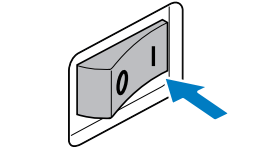
10.Select a stitch.
• For details on selecting a stitch, refer to “Selecting a stitch” (page 39).
• For details on the stitches that can be sewn with the twin needle, refer to “STITCH SETTINGS” (page 82).
11.Start sewing.
For details on starting to sew, refer to “Starting to sew” (page 41).

REPLACING THE PRESSER FOOT
Replacing the presser foot
1.Raise the needle by turning the handwheel toward you (counterclockwise) so that the mark on the wheel points up. (With models equipped with (needle position button), raise the needle by pressing
(needle position button), raise the needle by pressing  once or twice.)
once or twice.)

2.If the sewing machine has been turned on, turn it off.
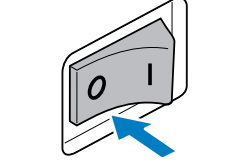
3.Raise the presser foot lever.
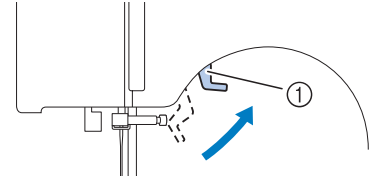
1. Presser foot lever
4.Press the black button at the back of the presser foot holder to release the presser foot.

1. Black button
2. Presser foot holder
5.Place a different presser foot below the holder so that the presser foot pin is aligned with the shank in the holder.
Position the presser foot so the letter indicating the presser foot type (J, A, etc.) is positioned to be read.
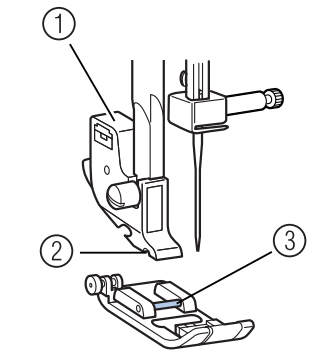
1. Presser foot holder
2. Shank
3. Pin
6.Slowly lower the presser foot lever so that the presser foot pin snaps into the shank in the presser foot holder
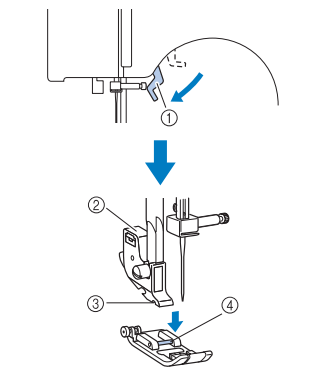
1.Presser foot lever
2. Presser foot holder
3. Shank d Pin
7.Raise the presser foot lever to check that the presser foot is securely attached.
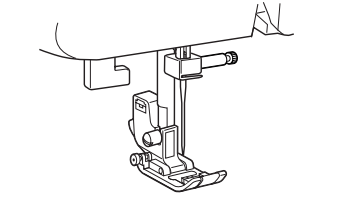
USEFUL SEWING TIPS
Trial sewing
After you select a stitch, the machine automatically sets the stitch width and length for the stitch that is selected. However, a trial piece of fabric should be sewn since, depending on the type of fabric and stitching being sewn, the desired results may not be achieved. For the trial sewing, use a piece of fabric and thread that are the same as those used for your project, and check the thread tension and stitch length and width. Since the results differ depending on the type of stitching and the number of layers of fabric sewn, perform the trial sewing under the same conditions that will be used with your project.
Changing the sewing direction
1.When the stitching reaches a corner, stop the sewing machine.
Leave the needle lowered (in the fabric). If the needle was raised, lower the needle either by turning the handwheel toward you (counterclockwise) or by pressing  (needle position button) once (for models equipped with the needle position button).
(needle position button) once (for models equipped with the needle position button).
2.Raise the presser foot lever, and then turn the fabric.
Turn the fabric using the needle as a pivot.
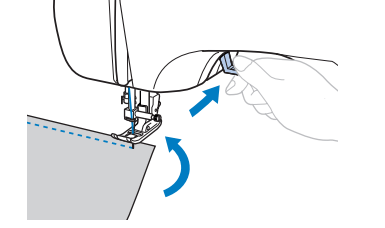
3.Lower the presser foot lever and continue sewing.
Sewing curves
Stop sewing, and then slightly change the sewing direction to sew around the curve.
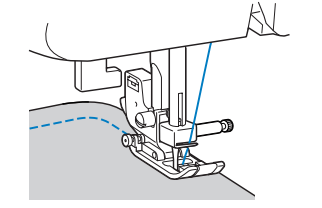
When sewing along a curve while using a zigzag stitch, select a shorter stitch length in order to obtain a finer stitch.
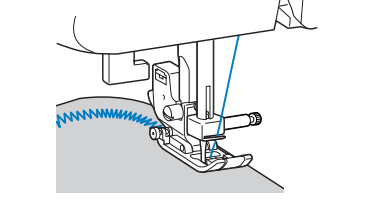
Sewing thick fabrics
■ If the fabric does not fit under the presser foot If the fabric does not fit easily under the presser foot, raise the presser foot lever even higher to bring the presser foot to its highest position.
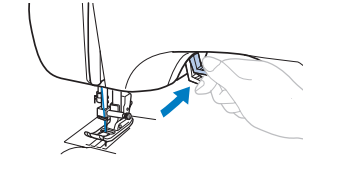
■ If thick seams are being sewn and the fabric does not feed at the beginning of stitching The fabric may not feed when thick seams are being sewn and the presser foot is not level, as shown below. In this case, use the presser foot locking pin (black button on the left side of zigzag foot “J”) so that the presser foot remains level while sewing, allowing the fabric to be fed smoothly

1. Sewing direction
1.Raise the presser foot lever.
2.Align the beginning of stitching, and then position the fabric.
3.While holding zigzag foot “J” level, hold the presser foot locking pin (black button on the left side) pressed in, and lower the presser foot lever.
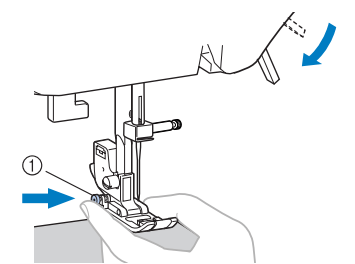
1. Presser foot locking pin (black button)
4.Release the presser foot locking pin (black button).
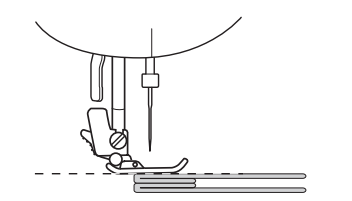
• After the seam is sewn, the presser foot will return to its original angle.
Sewing thin fabrics
When sewing thin fabrics, the stitching may become misaligned or the fabric may not feed correctly. Move the needle (be to use a fine needle) to the furthest left or righthand position so that the fabric does not get pulled down into the feed dog area. If this occurs, place thin paper or stabilizer material under the fabric and sew it together with the fabric. When you have finished sewing, tear off any excess paper.

1.Stabilizer material or paper
Sewing stretch fabrics
First, baste the pieces of fabric together, and then sew without stretching the fabric.

1. Basting
Stitching cylindrical pieces
1.Pull the flat bed attachment to the left to release it.
<Open type flat bed attachment>
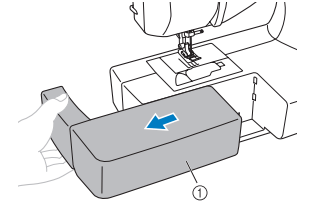
1. Flat bed attachment
<Slide type flat bed attachment>
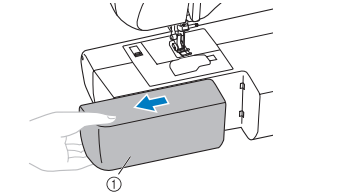
2.Slide the part that you wish to sew onto the arm, and then sew from the top.

MAINTENANCE
Restrictions on oiling
In order to prevent damaging this machine, it must not be oiled by the user. This machine was manufactured with the necessary amount of oil applied to ensure correct operation, making periodic oiling unnecessary. If problems occur, such as difficulty turning the handwheel or an unusual noise, immediately stop using the machine, and contact your authorized dealer or the nearest authorized service center.
Precautions on storing the machine
Do not store the machine in any of the locations described below, otherwise, damage to the machine may result, for example, rust caused by condensation
• Exposed to extremely high temperatures
• Exposed to extremely low temperatures
• Exposed to extreme temperature changes
• Exposed to high humidity or steam
• Near a flame, heater or air conditioner
• Outdoors or exposed to direct sunlight
• Exposed to extremely dusty or oily environments
Cleaning the machine surface
If the surface of the machine is dirty, lightly soak a cloth in neutral detergent, squeeze it out firmly, and then wipe the surface of the machine. After cleaning it once with a wet cloth, wipe it again with a dry cloth.
Cleaning the race
Sewing performance will suffer if dust collects in the race therefore, it should be cleaned periodically.
1.Switch the machine off and unplug it
2.Raise the needle and the presser foot.
3.Loosen the presser-foot screw and the needle clamp screw to remove the presser-foot holder and the needle.
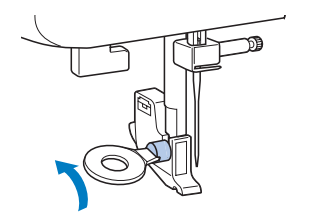
4.Slide the needle plate cover release toward you to remove the needle plate cover

1. Needle plate cover
2. Needle plate cover release
5.Remove the bobbin case

1. Bobbin case
6.Use the cleaning brush or a vacuum cleaner to remove any dust from the race and its surrounding area.
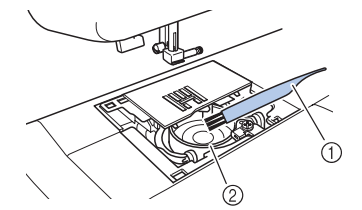
1. Cleaning brush
2. Race
7.Insert the bobbin case so that the S mark on the bobbin case aligns with the z mark on the machine.
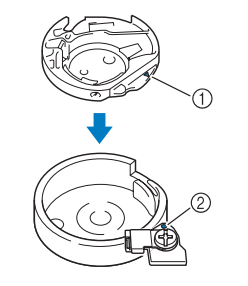

• Align the  and
and  marks.
marks.
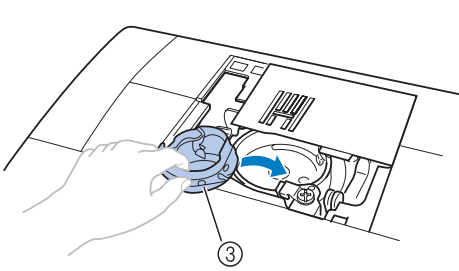
1.  mark
mark
2.  mark
mark
3. Bobbin case
• Make sure that the indicated points are aligned before installing the bobbin case.
8.As shown, insert the tab on the needle plate cover into the hole in the needle plate, and then correctly position of the needle plate cover.
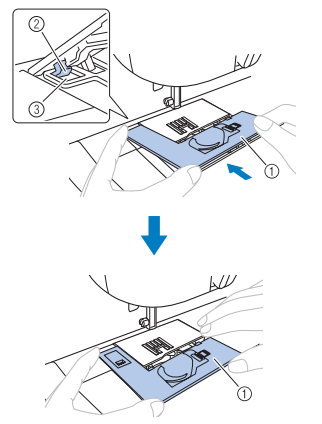
1. Needle plate cover
2. Tab
3. Hole
• Check that the needle plate cover is flush with the top surface of the machine.
9.From the front, slide the needle plate cover back into position.9

1. Needle plate cover
TROUBLESHOOTING
Upper thread tightened up
Symptom
• The upper thread appears as a single continuous line.
• The lower thread is visible from the upper side of the fabric. (Refer to the illustration below.)
• The upper thread has tightened up, and comes out when pulled.
• The upper thread has tightened up, and wrinkles appear in the fabric.
• The upper thread tension is tight, and the results do not change even after the thread tension is adjusted.
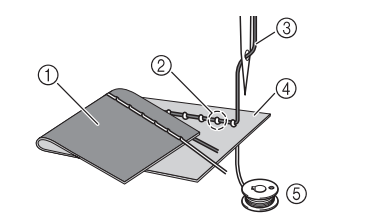
1. Lower side of fabric
2. Lower thread visible from upper side of fabric
3. Upper thread
4. Upper side of fabric
5. Lower thread
Cause
Incorrect lower threading
If the lower thread is incorrectly threaded, instead of the appropriate tension being applied to the lower thread, it is pulled through the fabric when the upper thread is pulled up. For this reason, the thread is visible from the upper side of the fabric.
Remedy/check details
Correctly install the lower thread.
1.Turn off the sewing machine.
2.Remove the bobbin from the bobbin case.
3.Place the bobbin in the bobbin case so that the thread unwinds in the correct direction.
• Hold the bobbin with your right hand with the thread unwinding to the left, and hold the end of the thread with your left hand. Then, with your right hand, place the bobbin in the bobbin case.
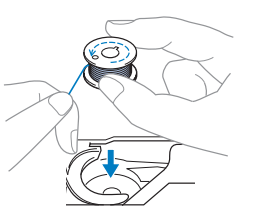
If the bobbin is inserted with the thread unwinding in the wrong direction, sewing will be done with an incorrect thread tension.
4.While holding the bobbin in place with your finger, pass the thread through the slit in the needle plate.
• Hold down the bobbin with your right hand, and then pull the end of the thread around the tab with your left hand.

1. Tab
2. Hold down the bobbin with your right hand.
On models equipped with the quick-set bobbin, pull the thread to pass it through the slit in the needle plate, then cut it with the cutter.
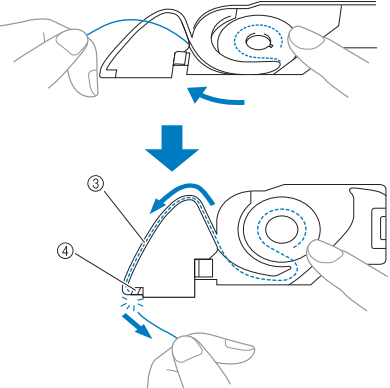
3. Slit
4. Cutter
Sewing with the correct thread tension is possible after the bobbin has been correctly installed in the bobbin case.
Tangled thread on wrong side of fabric
Symptom
• The thread becomes tangled on the lower side of the fabric.

• After starting sewing, a rattling noise is made and sewing cannot continue.
• Looking under the fabric, there is tangled thread in the bobbin case.
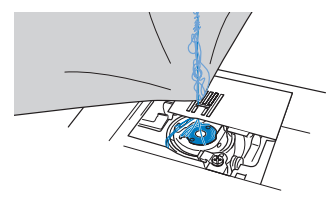
Cause
Incorrect upper threading
If the upper thread is incorrectly threaded, the upper thread passed through the fabric cannot be firmly pulled up and the upper thread becomes tangled in the bobbin case, causing a rattling noise.
Remedy/check details
Remove the tangled thread, and then correct the upper threading.
1.Remove the tangled thread. If it cannot be removed, cut the thread with scissors.
• For details, refer to “Cleaning the race” on page 91.
2.Remove the upper thread from the machine.
3.Refer to the following steps to correct the upper threading.
• If the bobbin was removed from the bobbin case, refer to “Lower threading” (page 22) and “Remedy/check details” in the section “Upper thread tightened up” (page 94) to correctly install the bobbin.
4.Raise the presser foot using the presser foot lever.
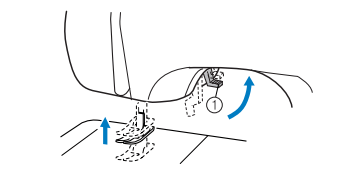
1. Presser foot lever
• If the presser foot is not raised, the sewing machine cannot be threaded correctly
5.Raise the needle by turning the handwheel toward you (counterclockwise) so that the mark on the wheel points up, or press (needle position button) (for models equipped with the needle position button) once or twice to raise the needle.
(needle position button) (for models equipped with the needle position button) once or twice to raise the needle.

1. Mark
2. Needle position button
6.Pull some thread off the spool, and then pass the thread under the thread guide.
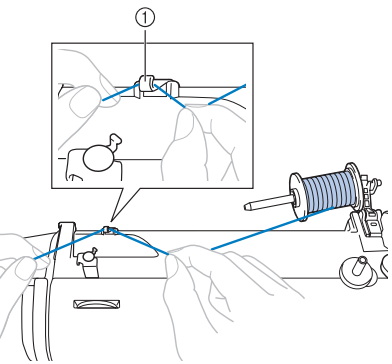
1. Thread guide
7.Pass the thread under the thread guide cover from the back to the front.
Hold the thread with your right hand so that there is no slack in the thread that is pulled out, and then pass the thread under the thread guide cover with your left hand.

1.Thread guide cover
8.Feed the upper thread as shown in the illustration below.
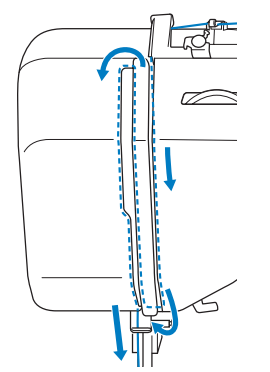
9.Make sure you guide the thread through the thread take-up lever from right to left as shown in the illustration below.
Sewing is possible only if the thread is securely hooked on the thread take-up lever.
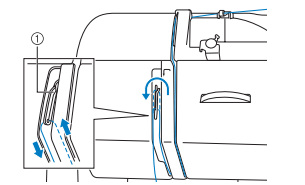
1. Thread take-up lever
• Make sure that the thread is securely hooked on the thread take-up lever.
10.Put the thread behind the needle bar thread guide above the needle.
The thread can easily be passed behind the needle bar thread guide by holding the thread in your left hand, then feeding the thread with your right hand.

1. Needle bar thread guide
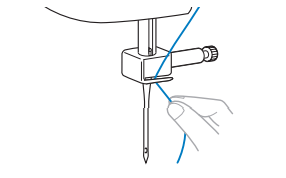
11.Thread the needle according to steps m and n in “Upper threading” (page 28) or steps b through i in “Using the needle threader (for models equipped with the needle threader)” (page 28).
Incorrect thread tension
Symptoms
• Symptom 1: The lower thread is visible from the upper side of the fabric.
• Symptom 2: The upper thread appears as a straight line on the upper side of the fabric.
• Symptom 3: The upper thread is visible from the lower side of the fabric.
• Symptom 4: The lower thread appears as a straight line on the lower side of the fabric.
• Symptom 5: The stitching on the lower side of the fabric is loose or has slack.
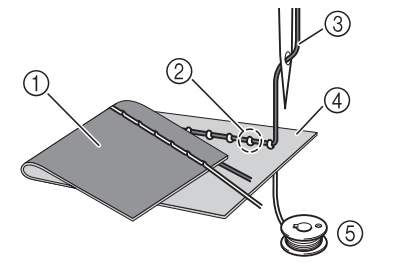
Symptom 1
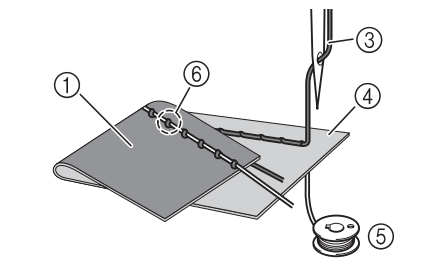
Symptom 3
1.Lower side of fabric
2. Lower thread visible from upper side of fabric
3. Upper thread d Upper side of fabric
4. Lower thread
5. Upper thread visible from lower side of fabric
Cause/remedy/check details
Cause 1
The machine is not correctly threaded. The lower threading is incorrect. Return the upper tension-control dial to “4”, and then refer to “Upper thread tightened up” (page 94) to correct the threading. The upper threading is incorrect. Return the upper tension-control dial to “4”, and then refer to “Tangled thread on wrong side of fabric” (page 95) to correct the upper threading
Cause 2
A needle and thread appropriate for the fabric are not being used. The sewing machine needle that should be used depends on the type of fabric sewn and the thread thickness. If a needle and thread appropriate for the fabric are not being used, the thread tension will not be adjusted correctly, causing wrinkles in the fabric or skipped stitches.
• Refer to “Needle types and their uses” (page 31) to check that a needle and thread appropriate for the fabric are being used.
Cause 3
An appropriate setting on the upper tension-control dial is not selected. Turn the upper tension-control dial to select an appropriate thread tension. The appropriate thread tension differs according to the type of fabric and thread being used.
* Adjust the thread tension while test sewing on a piece of scrap fabric that is the same as that used in your project.
Fabric is caught in the machine and cannot be removed
If the fabric is caught in the sewing machine and cannot be removed, the thread may have become tangled under the needle plate. Follow the procedure described below to remove the fabric from the machine. If the operation could not be completed according to the procedure, instead of attempting to complete it forcefully, contact your nearest authorized service center.
■ Removing the fabric from the machine
1.Immediately stop the sewing machine.
2.Turn off the sewing machine.
3.Remove the needle. If the needle is lowered into the fabric, turn the handwheel away from you (clockwise) to raise the needle out of the fabric, and then remove the needle.
• Refer to “Replacing the needle” (page 32).
4.Remove the presser foot and presser foot holder.
• Refer to “Replacing the presser foot” (page 36) and “Removing the presser foot holder” (page 37).
5.Lift up the fabric and cut the threads below it. If the fabric can be removed, remove it. Continue with the following steps to clean the race.
6.Remove the needle plate cover.

1.Needle plate cover release
2. Needle plate cover (front part)
7.Cut out the tangled threads, and then remove the bobbin.
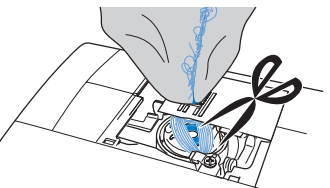
8.Remove the bobbin case. If threads remain in the bobbin case, remove them.

1.Bobbin case
9.Use the cleaning brush or a vacuum cleaner to remove any dust from the race and its surrounding area.
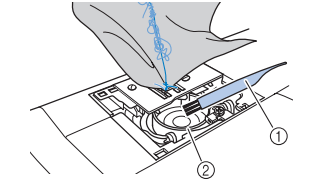
1. Cleaning brush
2. Race
- If the fabric could be removed Continue to step 16.
- If the fabric could not be removed Continue to step 10
10.Use the enclosed disc-shaped screwdriver to loosen the two screws on the needle plate.
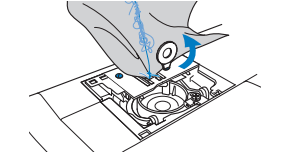
11.Slightly lift up the needle plate, cut any tangled threads, and then remove the needle plate.
Remove the fabric and threads from the needle plate.
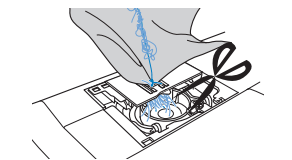
If the fabric cannot be removed, even after completing these steps, contact your nearest authorized service center.
12.Remove any threads in the race and around the feed dogs.
13.Turn the handwheel to raise the feed dogs.
14.Align the two screw holes in the needle plate with the two holes at the needle plate mounting base, and then fit the needle plate onto the machine.
15.Lightly finger-tighten the screw on the right side of the needle plate. Then, use the discshaped screwdriver to firmly tighten the screw on the left side. Finally, firmly tighten the screw on the right side.

Turn the handwheel to check that the feed dogs move smoothly and do not contact the edges of the slots in the needle plate.
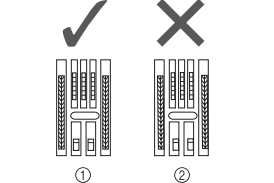
1. Correct position of feed dogs
2. Incorrect position of feed dogs
16.Insert the bobbin case so that the  mark on the bobbin case aligns with the
mark on the bobbin case aligns with the  mark on the machine.
mark on the machine.

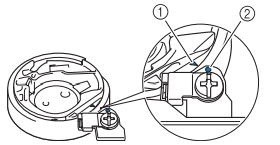
• Align the  and
and  marks.
marks.
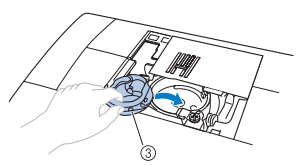
1. mark
mark
2. mark
mark
3. Bobbin case
• Make sure that the indicated points are aligned before installing the bobbin case.
17.Attach the needle plate cover according to steps 8 and 9 in “Cleaning the race” (page 93).
18.Check the condition of the needle, and then install it.
If the needle is in a poor condition, for example, if it is bent, be sure to install a new needle.
• Refer to “Checking the needle” (page 32) and “Replacing the needle” (page 32).
■ Checking machine operations
If the needle plate has been removed, check machine operations to confirm that installation has been completed correctly
1.Turn on the machine.
2.Select  (middle needle position stitch).
(middle needle position stitch).
3.Slowly turn the handwheel toward you (counterclockwise), and look from all sides to check that the needle falls at the center of the hole in the needle plate.
If the needle contacts the needle plate, remove the needle plate, and then install it again, starting with step 13 in “Removing the fabric from the machine” (page 100).

1. Hole in the needle plate
2. Handwheel
4.Select zigzag stitch . At this time, increase the stitch length and width to their maximum settings.
. At this time, increase the stitch length and width to their maximum settings.
• For details on changing the settings, refer to “Adjusting the stitch length and width” (page 40).
5.Slowly turn the handwheel toward you (counterclockwise) and check that the needle bar and feed dogs operate correctly.
If the needle or feed dogs contact the needle plate, the machine may be malfunctioning; therefore, contact your nearest authorized service center.
6.Turn off the machine, and then install the bobbin and presser foot.
• Refer to “Lower threading” (page 22) and “Replacing the presser foot” (page 36).
7.Correctly thread the machine.
• For details on threading the machine, refer to “Upper threading” (page 25)
8.Perform trial sewing with normal fabric
Error message “E6” appears in the LCD
If the error message “E6” appears in the LCD with the occurrence of one of the following symptoms, follow the procedure below to solve the problem.
Symptom 1 : The machine rattles and then stops just after sewing is started.
■ Cause
• The upper thread is not threaded correctly.
• The thread take-up lever is not threaded. * When the machine stops just after sewing is started, the upper thread may not be threaded correctly.
■ Remedy Thread the upper thread again correctly by following the procedure below
1.Turn off the machine
2.If the thread is tangled, remove the tangled thread.
• Refer to “Cleaning the race” (page 91) and “Tangled thread on wrong side of fabric” (page 95).
3.Remove the upper thread from the machine.
4.Turn the handwheel toward you (counterclockwise) to check if the handwheel moves smoothly.
• If the handwheel moves smoothly Continue to step 10.
• If the handwheel does not move smoothly Continue to step e.
5.Remove the needle plate cover, and then remove the bobbin and bobbin case.
6.Insert the bobbin case so that the  mark on the bobbin case aligns with the
mark on the bobbin case aligns with the  mark on the machine.
mark on the machine.
• Refer to “Cleaning the race” (page 91).
7.Attach the needle plate cover.
• Refer to “Cleaning the race” (page 91).
8.Set the bobbin in the bobbin case. • Refer to “Cleaning the race” (page 91).
9.If the needle is bent, replace it with a new one.
• Refer to “Replacing the needle” (page 32).
10.Turn on the machine, and then press the needle position button to raise the needle.
• Refer to “Upper threading” (page 25).
11.Thread the machine correctly.
• For details on threading the machine, refer to “Upper threading” (page 25).
Symptom 2 : The upper thread is tangled, for example, in the race, or fabric is caught in the machine.
■ Cause Thread is tangled below the needle plate.
■ Remedy Remove the fabric and reset the thread and bobbin by following the procedure below.
1.Turn off the machine.
2.Remove the fabric from the machine.
• Refer to “Fabric is caught in the machine and cannot be removed” (page 99).
3.Remove the upper thread and bobbin.
• Refer to “Fabric is caught in the machine and cannot be removed” (page 99).
4.Remove the bobbin case.
• Refer to “Fabric is caught in the machine and cannot be removed” (page 99).
5.If threads remain in the bobbin case, remove it.
• Refer to “Fabric is caught in the machine and cannot be removed” (page 99).
6.Insert the bobbin case so that the  mark on the bobbin case aligns with the
mark on the bobbin case aligns with the  mark on the machine.
mark on the machine.
• Refer to “Cleaning the race” (page 91)
7.Attach the needle plate cover.
• Refer to “Cleaning the race” (page 91).
8.Set the bobbin in the bobbin case.
• Refer to “Cleaning the race” (page 91).
9.If the needle is bent, replace it with a new one.
• Refer to “Replacing the needle” (page 32).
10.Turn on the machine, and then press the needle position button to raise the needle.
• Refer to “Upper threading” (page 25).
11.Thread the machine correctly.
• For details on threading the machine, refer to “Upper threading” (page 25).
Symptom 3 : The needle breaks, or the needle bends and thus hits the needle plate.
■ Cause
You have not used the right combination of fabric, thread and needle.
■ Remedy
Choose a thread and needle that are appropriate for the type of fabric.
• Refer to “Needle types and their uses” (page 31).
Symptom 4 : The fabric is not fed.
■ Cause
The thread has become clogged as the stitch is too fine.
■ Remedy
Lengthen the stitch length.
• Refer to “Adjusting the stitch length and width” (page 40).
List of symptoms
■ Before sewing
Symptom | Possible cause | How to put it right |
| The needle threader can not be used. (For models equipped with the needle threader lever.) | You have not moved the needle holder to its highest position. | Raise the needle either by turning the handwheel toward you (counterclockwise) so that the mark on the wheel points up or by pressing  (needle position button) once or twice. (needle position button) once or twice. |
| The needle is incorrectly installed | Correctly install the needle. | |
| The sewing light does not come on. | The machine is not turned on | Turn on the machine. |
| Bobbin thread does not wind neatly on the bobbin. | The thread is not passed through the bobbin-winding thread guide correctly | Correctly pass the thread through the bobbin-winding thread guide. |
| Bobbin spins slowly. (for models equipped with the sewing speed controller.) | Move the sewing speed controller to the right (so that the speed will be fast). | |
| The thread that was pulled out was not wound onto the bobbin correctly. (For models equipped with the fast bobbin winding system.) | Wind the thread that was pulled off round the bobbin five or six times clockwise. | |
| The thread does not pass through the eye of the needle. (For models equipped with the needle threader lever.) | You have not moved the needle holder to its highest position. | Raise the needle either by turning the handwheel toward you (counterclockwise) so that the mark on the wheel points up or by pressing  (needle position button) once or twice. (needle position button) once or twice. |
| The needle is incorrectly installed. | Correctly install the needle. | |
| The needle threader lever does not lower to the correct position. (For models equipped with the needle threader lever.) | The needle has not been raised to the correct position. | Press the needle position button. |
| While winding the bobbin, the bobbin thread was wound below the bobbin winder seat. | You have not wound the bobbin thread properly | After removing the thread wound below the bobbin winder seat, wind the bobbin correctly |
■ While sewing
Symptom | Possible cause | How to put it right |
| The sewing machine does not work. | The machine is not plugged in. | Plug the machine in. |
| The main power switch is turned off. | Turn on the main power switch. | |
| The bobbin winder shaft is pushed to the right. | Move the bobbin winder shaft to the left. | |
| You have not used the foot controller properly. | Use the foot controller properly | |
| The foot controller or the start/stop button was not pressed (for models equipped with the start/stop button). | Press the foot controller or the start/ stop button. | |
| The presser foot lever is raised. | Lower the presser foot lever. | |
| The start/stop button was pressed, even though the foot controller is connected. (for models equipped with the start/stop button) | Do not use the start/stop button when the foot controller is connected. To use the start/stop button, disconnect the foot controller. | |
| Fabric being sewn with the machine cannot be removed. | Thread is tangled below the needle plate. | Lift up the fabric and cut the threads below it, and clean the race. |
| The needle breaks. | The spool or spool cap is incorrectly installed. | Correctly install the spool or spool cap. |
| The upper thread was not threaded correctly. | Correct the upper threading. | |
| The needle is incorrectly installed. | Correctly install the needle. | |
| The needle clamp screw is loose. | Use the disc-shaped screwdriver to firmly tighten the screw. | |
| The needle is bent or blunt. | Replace the needle | |
| You have not used the right combination of fabric, thread and needle. | Choose a thread and needle that are appropriate for the type of fabric. | |
| The presser foot you are using is not appropriate for the type of stitch that you want to sew. | Attach the presser foot that is correct for the type of stitch that you want to sew. | |
| The upper thread tension is too tight. | Loosen the upper thread tension. | |
| You are pulling the fabric too much. | Lightly guide the fabric. | |
| The area around the hole in the needle plate is scratched. | Replace the needle plate. Contact your retailer or the nearest authorized service center. | |
| The area around the hole in the presser foot is scratched. | Replace the presser foot. Contact your retailer or the nearest authorized service center | |
| The bobbin case is scratched. | Replace the bobbin case. Contact your retailer or the nearest authorized service center. | |
| You have not used a bobbin that has been designed for this machine. | Incorrect bobbins will not work properly. Only use a bobbin that has been designed for this machine. | |
| The upper thread breaks. | The upper thread was not threaded correctly. (for example, the spool is not installed correctly, the spool cap is too big for the spool being used, or the thread has come out of the needle bar thread guide.) | Correct the upper threading. Use the spool cap that best fits the size of the spool being used. |
| There are knots or tangles in the thread. | Remove any knots or tangles. | |
| The needle is not appropriate for the thread you are using. | Choose a needle that is appropriate for the type of stitch. | |
| The upper thread tension is too tight. | Loosen the upper thread tension | |
| The thread is tangled, for example, in the race. | Remove the tangle thread. If the thread is tangled in the race, clean the race. | |
| The needle is bent or blunt. | Replace the needle. | |
| The needle is incorrectly installed. | Correctly install the needle. | |
| You have not used a bobbin that has been designed for this machine. | Replace the needle plate. Contact your retailer or the nearest authorised service center. | |
| The bobbin case is scratched, or has a burr on it. | Replace the bobbin case. Contact your retailer or the nearest authorised service center. | |
| You have not used a bobbin that has been designed for this machine. | Incorrect bobbins will not work properly. Only use a bobbin that has been designed for this machine. | |
| The lower thread is tangled or breaks. | You have not wound the bobbin thread properly. | Wind the bobbin thread properly. |
| The bobbin is scratched or does not turn smoothly. | Replace the bobbin. | |
| The thread is tangled. | Remove the tangled thread and clean the race. | |
| You have not used a bobbin that has been designed for this machine. | Incorrect bobbins will not work properly. Only use a bobbin that has been designed for this machine. | |
| Bobbin is set incorrectly. | Reset the bobbin thread correctly. | |
| The fabric is wrinkled. | You have not threaded the upper thread properly or fitted the bobbin properly | Thread the upper thread and wind the bobbin thread properly. |
| The spool or spool cap is incorrectly installed. | Correctly install the spool or spool cap. | |
| You have not used the right combination of fabric, thread and needle. | Choose a thread and needle that are appropriate for the type of fabric. | |
| The needle is bent or blunt. | Replace the needle. | |
| If thin fabrics are being sewn, the stitch is too long or the fabric is not being fed correctly. | Sew with the stabilizer material under the fabric. | |
| If thin fabrics are being sewn, the stitch is too coarse. | Shorten the stitch length, or sew with stabilizer material under the fabric. | |
| The fabric is wrinkled. | The presser foot you are using is not appropriate for the type of stitch that you want to sew. | Attach the presser foot that is correct for the type of stitch that you want to sew. |
| The thread tension is incorrect. | Adjust the tension of the upper thread. | |
| Stitches are skipped. | You have not threaded the upper thread properly. | Correct the upper threading. |
| You have not used the right combination of fabric, thread and needle. | Choose a thread and needle that are appropriate for the type of fabric. | |
| The needle is bent or blunt. | Replace the needle. | |
| The needle is incorrectly installed. | Correctly install the needle. | |
| Dust has accumulated under the needle plate or in the race. | Remove the needle plate cover and clean the plate and the race. | |
| There is a highpitched noise while sewing | Dust has built up in the feed dogs or in the race. | Remove the needle plate cover and clean the plate and the race. |
| You have not threaded the upper thread properly | Correct the upper threading | |
| The bobbin case is scratched. | Replace the bobbin case. Contact your retailer or the nearest authorized service center | |
| You have not used bobbin that has been designed for this machine. | Incorrect bobbins will not work properly. Only use a bobbin that has been designed for this machine. | |
| The fabric does not feed. | The feed dogs are lowered. | Slide the feed dog position lever to |
| The stitch is too fine. | Lengthen the stitch length. | |
| You have not used the right combination of fabric, thread and needle. | Choose a thread and needle that are appropriate for the type of fabric. | |
| The thread is tangled, for example, in the race. | Remove the tangle thread. If the thread is tangled in the race, clean the race. | |
| The presser foot you are using is not appropriate for the type of stitch that you want to sew. | Attach the presser foot that is correct for the type of stitch that you want to sew. | |
| The needle is bent or blunt | Replace the needle. | |
| Zigzag foot “J” is slanted on a thick seam at the beginning of stitching. | Use the presser foot locking pin (black button on the left side) on zigzag foot “J” to keep the presser foot level while sewing | |
| The fabric feeds in the opposite direction. | The feed mechanism is damaged. | Contact your retailer or the nearest authorized service center. |
■ After sewing
Symptom | Possible cause | How to put it right |
| The upper thread has tightened up. | The bobbin thread is incorrectly installed. | Correctly install the bobbin thread. |
| The thread tension is incorrect. | You have not threaded the upper thread properly | Correct the upper threading |
| You have not wound the bobbin thread properly. | Wind the bobbin thread properly. | |
| The bobbin thread is incorrectly installed. | Correctly install the bobbin thread. | |
| You have not threaded the right combination of thread and needle for the fabric you are using. | Choose a thread and needle that are appropriate for the type of fabric. | |
| You have not attached the presserfoot holder properly. | Attach the presser-foot holder properly | |
| The thread tension is incorrect. | Adjust the tension of the upper thread. | |
| You have not used a bobbin that has been designed for this machine. | Incorrect bobbins will not work properly. Only use a bobbin that has been designed for this machine. | |
| Bobbin is set incorrectly. | Reset the bobbin thread correctly | |
| The thread is tangled on the wrong side of the fabric. | You have not threaded the upper thread properly | Correct the upper threading |
| The stitch is not sewn correctly | The presser foot you are using is not appropriate for the type of stitch that you want to sew. | Attach the presser foot that is correct for the type of stitch that you want to sew. |
| The thread tension is incorrect. | Adjust the tension of the upper thread. | |
| The thread is tangled, for example, in the race. | Remove the tangle thread. If the thread is tangled in the race, clean the race. | |
| The stitch adjustment level is incorrect. | Adjust the stitch. |
ERROR MESSAGES
Error Message | Probable Cause | Solution |
 | The foot controller was pressed (or the start/ stop button was pressed if the foot controller is not connected) and the reverse/reinforcement stitch button was pressed while the presser foot is raised. | Lower the presser foot lever before continuing the operation. |
 | A stitch other than the buttonhole or bar tack stitch was selected and the foot controller was pressed (or the start/stop button was pressed if the foot controller is not connected) while the buttonhole lever is lowered. | Raise the buttonhole lever before continuing the operation. |
 | The buttonhole or bar tack stitch was selected and the foot controller was pressed (or the start/stop button was pressed if the foot controller is not connected) while the buttonhole lever is raised. | Lower the buttonhole lever before continuing the operation. |
 | The reverse/reinforcement stitch button or needle position button was pressed while the bobbin winder shaft is moved to the right. | Move the bobbin winder shaft to the left before continuing the operation. |
 | The start/stop button was pressed while the foot controller was connected. | Disconnect the foot controller, and then press the start/stop button. Otherwise, operate the machine by using the foot controller. |
 | The motor locked up because the thread became tangled, or the needle bent and thus hit the needle plate. | Clean the race to remove the tangled thread (page 91). Check the nContact your nearest authorized service center.eedle. If the needle is bent or broken, replace the needle (page 32). If both of the above fail, refer to “Error message “E6” appears in the LCD” (page 103). |
 | The machine may be malfunctioning. | Contact your nearest authorized service center. |
See other models: ADS2700W MFC-3820CN MFC-L8850CDW MFC-L9570CDW MFC-J4620DW
